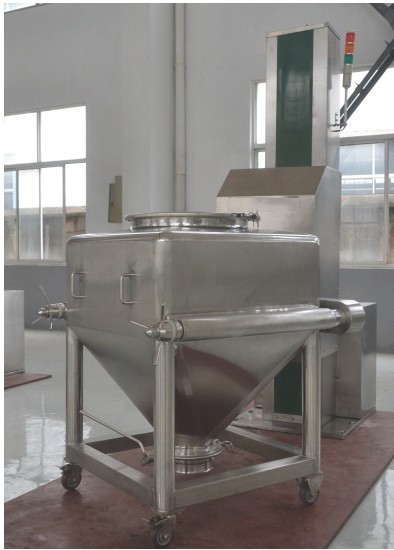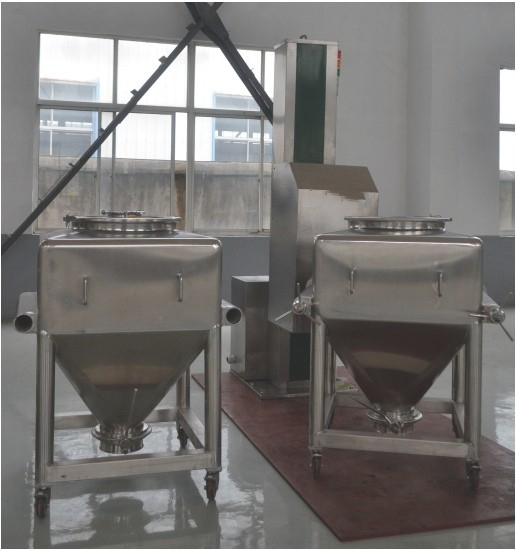
17 Jul Smart Manufacturing The Role of HTD-1000 in Modern Pharma Production
In the rapidly advancing world of pharmaceutical and food manufacturing, the demand for equipment that is not only efficient but also versatile and user-friendly has led to significant innovations. At the forefront of this evolution is the HTD-1000 Column Blender, a state-of-the-art machine designed to meet and exceed the expectations of modern manufacturers.
A Closer Look: The Column Blender HTD-1000’s Core Features
Capacity and Suitability
With a generous 1000L bin capacity, catering to substantial mixing needs while ensuring optimal loading rates of 50%-80% and a maximum loading capacity of 800kg. With a rotation speed adjustable between 3 to 15 revolutions per minute and working under pressures of 8 to 12.5 Mpa, it guarantees a thorough and consistent mix. the HTD-1000 Column Blender is manufactured to suit the high-volume needs of the industry. It is not just about the size; the blender’s design ensures that users can achieve the perfect blend, every time, without the worry of cross-contamination or dust pollution. This feature is especially crucial in the pharmaceutical and food sectors, where product purity is paramount.
Versatility for Various Industries
The blending capacity of the HTD-1000 is not limited to a single industry. Manufactured with versatility in mind, it finds applications across pharmaceuticals, food, and fine chemicals. The secret lies in its ability to mix solid particles and powders efficiently, allowing for a seamless transition between different types of materials and batches.

User-Friendly Design
Understanding the needs of its users, the HTD-1000 is equipped with an intuitive human-machine interface. The touch screen panel simplifies operation, allowing users to store and recall up to 20 sets of process parameters. This added layer of automation saves valuable time and ensures consistency across batches, a feature that is particularly beneficial when dealing with diverse materials or adjusting production scales.
Enhanced Safety and Efficiency
Safety is not an afterthought with the HTD-1000. The column blenders come equipped with an infrared photoelectric sensor, ensuring the safety of personnel during operation. Furthermore, its hydraulic lifting system showcases the integration of technology and safety, featuring a safety lock device and a position sensor to prevent unexpected movements, thereby safeguarding both the product and the operator.
Meeting the Needs of Modern Manufacturing
Designed for Today, With Tomorrow in Mind
The HTD-1000 Column Blenders is more than just a piece of equipment; it’s a solution designed to meet the evolving needs of the manufacturing industry. Its compact footprint and low dead weight make it an ideal choice for facilities where space is at a premium, yet production capacity cannot be compromised. Additionally, it meets the rigorous FDA/cGMP standards, making it a valuable asset for manufacturers aiming to comply with international quality standards.
Innovation That Adds Value
Beyond its primary function of blending, the HTD-1000 offers features that add significant value to any manufacturing operation. Its capability to be fitted with multiple bins is not just a testament to its versatility but also to its ability to facilitate strict batch number management. This feature is particularly advantageous for pharmaceutical enterprises where batch tracking and integrity are critical.

What are the parts of a bin blender?
A bin blender is outfitted with a PLC control system, mechanisms for driving, systems dedicated to lifting and descending, a braking system, and a rotary frame. The automated processes within the IBC bins are optimized through the hopper’s use, streamlining the handling and processing of materials.
What is the difference between a bin blender and a V blender?
The stark contrast between these two lies in the mobility of their containers. The bin blender boasts a movable container, offering the freedom to position it along the shaft as needed, catering to diverse operational layouts. On the flip side, the V blender’s container is anchored to its shaft, trading flexibility for increased stability in specific scenarios.
What delineates a blender from a mixer in their applications?
Blenders are tailored for the soft blending, mixing, and pureeing of food items and liquids, perfect for achieving smooth consistencies. Conversely, mixers are adept at grinding harder foods into fine particles or powders, broadening the scope of culinary preparation. Blenders are equipped with varied functionalities and attachments to meet a spectrum of blending requirements.
How does incorporating a hopper boost a bin blender system’s efficiency?
Integrating a hopper within a bin blender system elevates efficiency by smoothing the path for materials to be quickly loaded and unloaded. The hopper serves as a pocket, momentarily housing materials prior to their blend, which sustains operations and minimizes pauses between production cycles.
